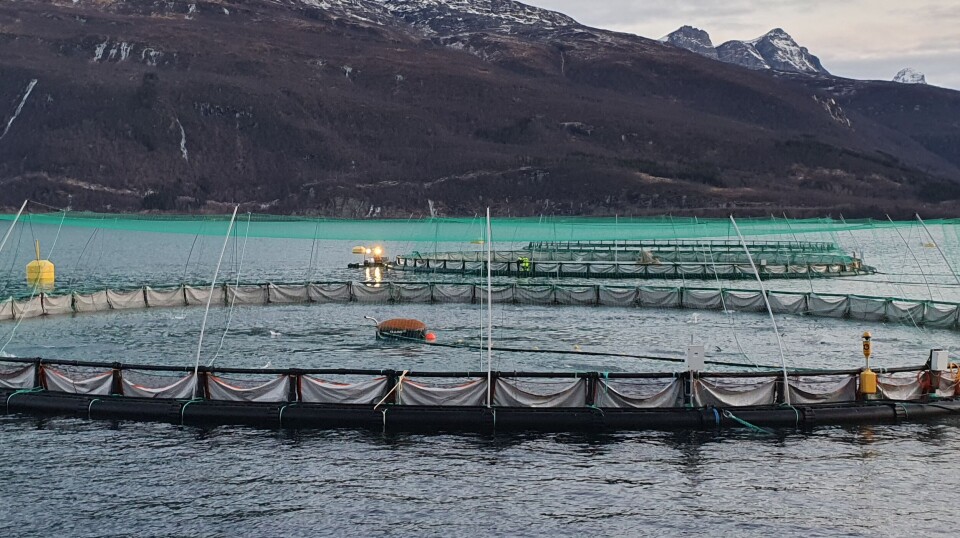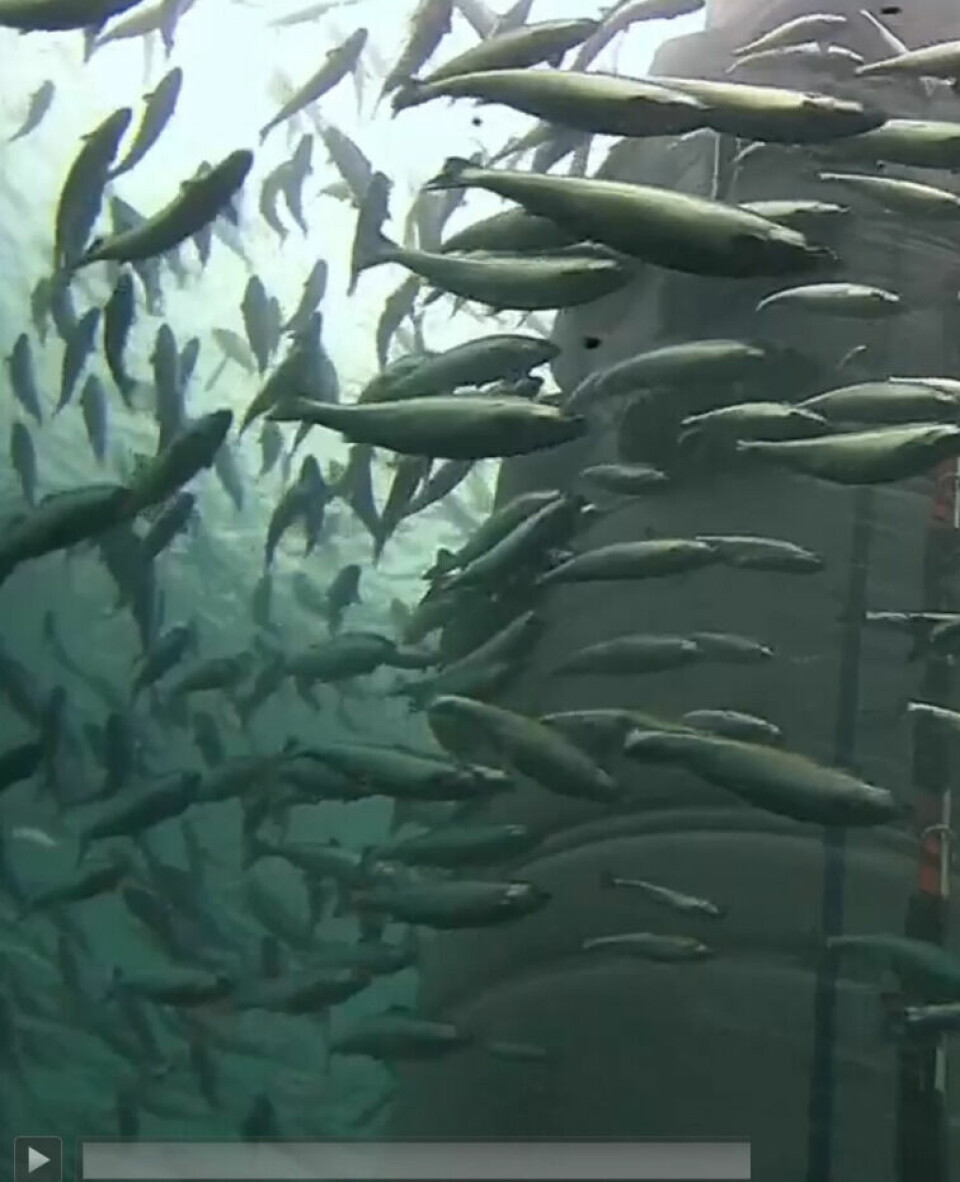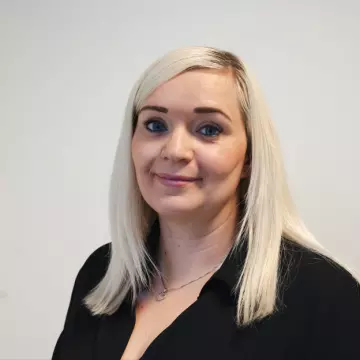
Lice levels stagnated with OptiCage cages
After a round of production using enhanced skirts and a central pump, a Norwegian partnership harvested a generation of spring fish without delousing
Salmon grown in pens equipped with snugly fitted lice skirts and in-cage pumps grew to harvest size without the need for lice treatment, a conference in Norway has heard.
Family-owned fish farmers Northern Lights Salmon and Sørrollnesfisk, who operate in partnership, launched the OptiCage system together with AKVA subsidiary Egersund Net and pump maker Framo in November 2022.
“It is important to look for solutions that are close by, and utilise existing infrastructure for sustainable results,” said Christian Balteskard, project manager for Northern Lights Salmon and Sørrollnesfisk when OptiCage was first launched.

“We have looked at how we can make ‘simple’ changes to adapt and optimise the conditions for the fish. In OptiCage we have assembled the most optimal solution.”
No delousing
Balteskard was one of the speakers at this year’s AqKva conference in Bergen last week, where he talked about the experiences the firms have had over the past year or so.
“In short, despite a number of challenges, we have harvested all the 2022 spring fish without delousing,” he said.
Balteskard said that in the development, the farmers, together with Egersund Net and Framo, have looked at how experience and expertise with almost standard products can be used to optimise cage conditions.
He pointed out that the lice larvae that infect salmon are found mainly from the sea surface and a few metres down. To prevent infestation of salmon lice, farmers must therefore shield the fish from the top layer of the water column.
“There is therefore a need for more tools. Farming on land or in closed cages are perfectly good, but very demanding solutions that very few farmers can use. Submersible cages, snorkel cages and similar concepts exist and work well in many places, but these have their own challenges and are also not suitable in all locations.”
15-metre skirts
Traditional louse skirts are one of the few traditional tools that Balteskard believes most farmers can use.
“But normal lice skirts often have a modest effect against lice infestations. OptiCage is a new cage concept for the salmon farmer’s toolbox, so that we who produce fish have more options to choose from,” he added.
The OptiCage comprises a 15-metre-deep lice skirt which is integrated with a modified “spaghetti” net from AKVA/Egersund Net, combined with a Framo AquaStream pump.
“The lice skirt is shaped to fit the nets and is fixed both on the surface and down at a depth of 15 metres. This reduces deformation of the net and skirt in the tidal flow, so that the cage protects against lice larvae under most conditions. At the centre of the cage is an AquaStream, a powerful water improver supplied by Framo which maintains the water quality in the cage by pumping up fresh (sea)water that flows through the cage under the lice skirts,” Balteskard explained.
Existing infrastructure
One of the advantages of OptiCage, he believes, is that the cage is suitable for many of the locations in use today and with existing infrastructure and accessories.
“Nets and lice skirts are well-known equipment in the farming industry, which simplify both assembly and daily use,” said Balteskard. “Nets and lice skirts can be installed in standard flotation collars and in normal frame moorings, and most of the installation work can be carried out by employees on service boats. The cage concept is also safe, flexible, and easy to understand, as you can see the fish from the edge of the cage.
“The farmer can choose to keep the fish in the cage throughout all or part of the production, and when it is desired or necessary, the cage can be converted from an OptiCage to a normal open cage in a short time.”
The OptiCage project has been carried out at the Ystevika site, where Northern Lights Salmon has a joint operation with Sørrollsnesfisk.

750,000 smolts
“In May 2022, we released 750,000 smolts in four 130-metre cages with traditional lice skirts,” recounted Balteskard. “In October and November, these were moved to OptiCage cages. After this, we put out three cages with autumn fish, two of which were put directly into OptiCage cages. The autumn fish are still in the sea, so the presentation at the AqKva conference is mainly about the spring fish which have now been slaughtered.”
All the spring fish were moved to the new cages by wellboat in October and November.
“This was during a period when all the arrows from the automatic lice cameras were pointing upwards. The development of the lice level stagnated after the OptiCage cages were put into use and then declined throughout the winter months,” said Balteskard. “The winter and cold sea temperatures gave us some technical challenges, and when spring returned and the temperature rose we discovered several problems that required a lot of effort to sort out. Some challenges remain, but the teething troubles that gave us the most problems have been solved, so that the next generation should be easier.”
Balteskard is satisfied with the results that have come from the first generation but said things can be made even better.
“During the summer and early autumn, we harvested the four cages of spring fish on the site without any form of delousing. All the cages were harvested in two rounds, and in the last period before slaughter, the cages were converted from OptiCage to normal cages while the salmon were still in the nets. The spring fish ended up with decent growth (EGI 108-117), biological feed factor 1.04-1.10 and a superior proportion of over 90%, figures which one must be able to say are good figures, but also which we will certainly be able to improve,” Balteskard stated.




































































